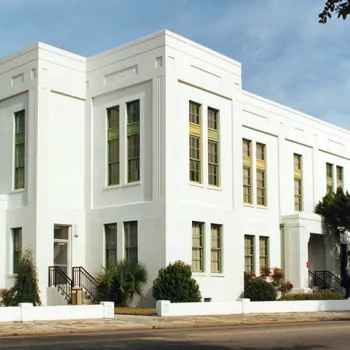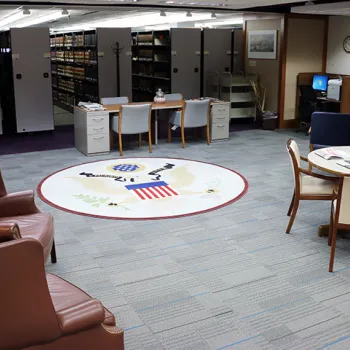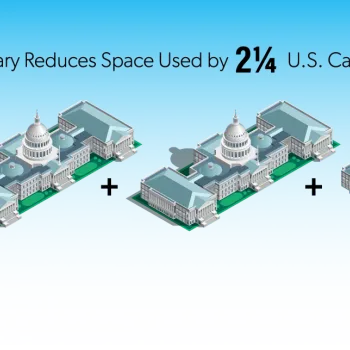The federal Judiciary has succeeded dramatically in its five-year quest to reduce building space and rental costs, exceeding its original reduction goals by nearly 30 percent.
In a recent ceremony, Judiciary leaders declared that they had reduced building space by more than 1.1 million square feet—far greater than the 870,000 feet they had targeted when the campaign began in September 2013. Rent has been cut more than $36 million a year, and that amount will increase when additional space comes off the rent bill before Dec. 31.
“The space reduction program is an unprecedented cost-containment effort that has yielded unprecedented results,” said Judge Susan Bolton, chair of the Judicial Conference Space and Facilities Committee. “Nationally, the total reduction translates into approximately $36 million in annual rent avoidance. It is a gift that keeps on giving.”
James C. Duff, director of the Administrative Office of the U.S. Courts (AO), said the program reflects the Judiciary’s commitment to prudent and efficient spending. “As public servants, we as the third branch owe the American taxpayers reasonable access to justice throughout the nation in a fiscally responsible manner,” Duff said.
The effort involved all levels of the Judiciary and also required close partnership with the General Services Administration, the federal government’s landlord and property manager. A Nov. 27 ceremony celebrating the program’s success was attended by GSA officials, AO staff, and managers of the 12 geographic circuits’ space and facilities programs.
The Judicial Conference of the United States initiated the campaign at a time when budget shortfalls were affecting all government branches. Rent bills for courthouses and support offices were accounting for nearly a quarter of the Judiciary’s annual budget. The Judiciary’s goal was to cut space by 3 percent.
Judge D. Brooks Smith, chief judge of the U.S. Court of Appeals for the Third Circuit and former chair of the Judiciary’s Space and Facilities Committee, said he was skeptical that all courts would support the project when it began in 2013.
“I emphasized one recurring theme. In order for space reduction to be successful, it was going to require the judicial family to examine its space district by district, city by city, and building by building,” Smith said. “The entire judicial family stepped up to the plate.”
All 12 regional circuits exceeded their goals. Among the reductions, federal courts of appeals accounted for 24 percent, district courts accounted for 22 percent, and bankruptcy courts represented 33 percent of Judiciary space savings. Probation and pretrial services offices provided 17 percent of the overall goal. In some cases, courts reduced leasing costs by combining different court operations, such as bankruptcy and district courts, into one federally owned building.
The campaign will have ongoing benefits to the public and the courts. The annual savings will repay themselves indefinitely in the form of lower rent bills. The Judiciary also has committed itself to a “No Net New” policy in which the courts will offset new space acquisitions with equivalent space reductions.
“This was a huge idea, it was ambitious as a goal, and it was executed with precision and hard work,” said Judge Karen K. Caldwell, of the Judicial Conference Committee on the Budget. “Over five years we will have recognized $180 million savings in rent. When we say we are serious about respecting the taxpayer dollar and working within our means, we mean business.”
“The Judiciary would never have achieved, let alone exceeded, this goal without the coordinated hard work by the circuits, courts, GSA, and AO staff," said Melanie Gilbert, chief of the AO Facilities and Security Office. "It was a real team effort supported by the leadership of each of our organizations."
The following projects are highlights of the Judiciary’s space reduction campaign:
- The District of New Hampshire Bankruptcy Court was relocated from leased space in Manchester into the District Court in Concord, NH. Savings: 20,000 square feet, most of the First Circuit’s goal.
- New York state: In Buffalo, the Bankruptcy Court relocated into the district courthouse. In Manhattan, the Bankruptcy Court reduced space by digitizing paper records. Combined savings: 39,000 square feet.
- In Philadelphia, an innovative open-space project reduced chambers space for out-of-town judges and staff.
- Library reductions in Camden, NJ; Wilmington, DE; Harrisburg, PA; Philadelphia; and U.S. Virgin Islands saved over 18,000 square feet.
- Non-resident courthouses (no permanently assigned judge) were closed in Bryson City, NC; Wilkesboro, NC; Beaufort, SC; and Parkersburg, WV. Total savings: over 35,000 square feet.
- In New Orleans, several open-design projects were executed, and circuit senior staff attorneys reduced nearly 10,000 square feet by paring book collections and reducing training and conference facilities.
- In Cincinnati, the Circuit Library Headquarters relocated to space formerly used for Clerk’s Office file storage. Total savings: 15,000 square feet.
- In Chicago, the Probation Office relocated 102 staff from leased space to an open plan design in the John C. Kluczynski Federal Building. Savings: 31,000 square feet and $1.4 million in annual rent.
- In St. Louis, numerous space reductions, including the redesign of chambers for four senior judges, saved over 30,000 square feet in the Thomas F. Eagleton U.S. Courthouse.
- In San Diego, the Probation Office saved 20,000 square feet and $800,000 in annual rent by moving leased offices into the Edward J. Schwarz U.S. Courthouse.
- In San Francisco, the Bankruptcy Court saved over 25,000 square feet and $1.5 million in annual rent by moving into the Phillip Burton Federal Building and U.S Courthouse.
- In Albuquerque, NM, the Bankruptcy Court saved 35,000 square feet by relocating into the Peter V. Domenici U.S. Courthouse.
- In Muskogee, OK, a Bankruptcy Court was relocated into the District Court’s courthouse, saving over 11,000 square feet.
- In Miami, 33,000 square feet and $900,000 in annual rent were saved by relocating the Bankruptcy Court into the C. Clyde Atkins U.S. Courthouse. Two magistrate judges were relocated, and a circuit library and jury assembly area were vacated.
Video
In Chicago, the Probation Office relocated 102 staff from leased space to an open plan design in the John C. Kluczynski Federal Building. Savings: 31,000 square feet and $1.4 million in annual rent.
Subscribe to News Updates
Subscribe to be notified when the news section is updated.





